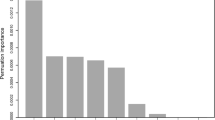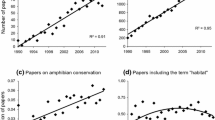Abstract
Quality conservation planning requires quality input data. However, the broad scale sampling strategies typically employed to obtain primary species distribution data are prone to geographic bias in the form of errors of omission. This study provides a quantitative measure of sampling bias to inform accuracy assessment of conservation plans based on the South African Frog Atlas Project. Significantly higher sampling intensity near to cities and roads is likely to result in overstated conservation priority and heightened conservation conflicts in urban areas. Particularly well sampled protected areas will also erroneously appear to contribute highly to amphibian biodiversity targets. Conversely, targeted sampling in the arid northwest and along mountain ranges is needed to ensure that these under-sampled regions are not excluded from conservation plans. The South African Frog Atlas Project offers a reasonably accurate picture of the broad scale west-to-east increase in amphibian richness and abundance, but geographic bias may limit its applicability for fine scale conservation planning. The Global Amphibian Assessment species distribution data offered a less biased alternative, but only at the cost of inflated commission error.







Similar content being viewed by others
Abbreviations
- SAFAP:
-
South African Frog Atlas Project
- QDGC:
-
Quarter Degree Grid Cell
- GAA:
-
Global Amphibian Assessment
References
Alexander GJ, Harrison JA, Fairbanks DH, Navarro RA (2004) Biogeography of the frogs of South Africa, Lesotho and Swaziland. In: Minter LR, Burger M, Harrison JA, Braack HH, Bishop PJ, Kloepfer D (eds) Atlas and Red Data Book of the Frogs of South Africa, Lesotho and Swaziland. SI/MAB Series #9. Smithsonian Institution, Washington DC
Berliner D, Desmet P (2007) Eastern Cape Biodiversity Conservation Plan: Technical Report. Department of Water Affairs and Forestry Project No 2005-012, Pretoria
Boakes EH, McGowan PJK, Fuller RJ, Chang-qing D, Clark NE, O’Connor K, Mace GM (2010) Distorted views of biodiversity: spatial and temporal bias in species occurrence data. PLoS Biol 8:e1000385
Carey C, Alexander MA (2003) Climate change and amphibian declines: is there a link? Divers Distrib 9:111–121
Chown SL, Van Rensburg BJ, Gaston KJ, Rodrigues ASL, Van Jaarsveld AS (2003) Energy, species richness, and human population size: conservation implications at a national scale. Ecol Appl 13:1233–1241
Dennis RLH, Shreeve TG (2003) Gains and losses of French butterflies: tests of predictions, under-recording and regional extinction from data in a new atlas. Biol Conserv 111:131–139
Dennis RLH, Sparks TH, Hardy PB (1999) Bias in butterfly distribution maps: the effects of sampling effort. J Insect Conserv 3:33–42
Desmet P, Cowling R (2004) Using the species-area relationship to set baseline targets for conservation. Ecol Soc 9:11 (online) http://www.ecologyandsociety.org/vol9/iss2/art11. Cited 30 July 2010
Desmet P, Schaller R, Skowno A (2008) North West Province Conservation Assessment Technical Report. North West Province Department of Agriculture, Conservation & Environment, Mafikeng
Donald PF, Fuller RJ (1998) Ornithological atlas data: a review of uses and limitations. Bird Study 45:129–145
Driver A, Maze K, Rouget M, Lombard AT, Nel J, Turpie JK, Cowling RM, Desmet P, Goodman P, Harris J, Jonas Z, Reyers B, Sink K, Strauss T (2005) National Spatial Biodiversity Assessment 2004: priorities for biodiversity conservation in South Africa. Strelitzia 17. South African National Biodiveristy Institute, Pretoria
Dunn AM, Weston MA (2008) A review of bird atlases of the world and their application. Emu 108:42–67
Eken G, Bennun L, Brooks TM, Darwall W, Fishpool LDC, Foster M, Knox D, Langhammer P, Matiku P, Radford E, Salaman P, Sechrest W, Smith ML, Spector S, Tordoff A (2004) Key biodiversity areas as site conservation targets. Bioscience 54:1110–1118
Elphick CS (1997) Correcting avian richness estimates for unequal sample effort in atlas studies. Ibis 139:189–190
Evans KL, Van Rensburg BJ, Gaston KJ, Chown SL (2006) People, species richness and human population growth. Glob Ecol Biogeogr 15:625–636
Fairbanks DHK, Kshatriya M, Van Jaarsveld AS, Underhill LG (2002) Scales and consequences of human land transformation on South African avian diversity and structure. Anim Conserv 5:61–73
Ferrar AA, Lötter MC (2007) Mpumalanga Biodiversity Conservation Plan Handbook. Mpumalanga Tourism and Parks Agency, Nelspruit
Ferreira D, Malard F, Dole-Olivier M, Gilbert J (2007) Obligate groundwater fauna of France: diversity patterns and conservation implications. Biodivers Conserv 16:567–596
Ferrier S (2002) Mapping spatial pattern in biodiversity for regional conservation planning: where to from here? Syst Biol 51:331–363
Ferrier S, Powell GVN, Richardson KS, Mannion G, Overton JM, Allnutt TF, Cameron SE, Mantle K, Burgess ND, Faith DP, Lamoreux JF, Kier G, Hijmans RJ, Funk VA, Cassis GA, Fisher BL, Flemons P, Lees D, Lovett JC, Van Rompaey RSAR (2004) Mapping more of terrestrial biodiversity for global conservation assessment. Bioscience 54:1101–1109
Freitag S, Hobson C, Biggs HC, Van Jaarsveld AS (1998) Testing for potential survey bias: the effect of roads, urban areas and nature reserves on a southern African mammal data set. Anim Conserv 1:119–127
Funk VA, Richardson KS (2002) Systematic data in biodiversity studies: use it or lose it. Syst Biol 51:303–316
Funk VA, Zermoglio MF, Nasir N (1999) Testing the use of specimen collection data and GIS in biodiversity exploration and conservation decision making in Guyana. Biodivers Conserv 8:727–751
Gaston K, Rodrigues ASL (2003) Reserve selection in regions with poor biological data. Conserv Biol 17:188–195
GDACE (2004) Chapter 8: Biodiversity. In: Gauteng Conservation State of the Environment Report. Gauteng Department of Agriculture, Conservation and the Environment, Gauteng Provincial Government
Graham CH, Ferrier S, Huettman F, Moritz C, Townsend Peterson A (2004) New developments in museum-based informatics and applications in biodiversity analysis. Trends Ecol Evol 19:497–503
Harrison JA, Minter LG, Burger M (2004) Atlas and Red Data book for frogs completed. S Afr J Sci 100:11–13
Harrison JA, Underhill LG, Barnard P (2008) The seminal legacy of the South African Bird Atlas Project. S Afr J Sci 104:82–84
IUCN (2001) Categories & criteria (version 3.1). Prepared by the IUCN Species Survival Commission. IUCN, Gland. http://www.iucnredlist.org/static/categories_criteria_3_1. Cited 23 April 2009
IUCN (2009) IUCN red list of threatened species. Version 2009.1. http://www.iucnredlist.org. Cited 15 June 2009
IUCN, Conservation International and Nature Serve (2008) An analysis of amphibians on the 2008 IUCN Red List. http://www.iucnredlist.org/amphibians. Cited 21 April 2009
Küper W, Sommer JH, Lovett JC, Barthlott W (2006) Deficiency in African plant distribution data—missing pieces of the puzzle. Bot J Linn Soc 150:355–368
Larsen FW, Bladt J, Rahbek C (2009a) Indicator taxa revisited: useful for conservation planning? Divers Distrib 15:70–79
Larsen R, Homern T, Prager SD, Maliti H, Roskaft E (2009b) Using the extended quarter degree grid cell system to unify mapping and sharing of biodiversity data. Afr J Ecol 47:382–392
Lenth RV (2006) Java applets for power and sample size [Computer software]. http://www.stat.uiowa.edu/~rlenth/Power. Cited 26 Feb 2009
Margules CR, Pressey RL (2000) Systematic conservation planning. Nature 405:243–253
McCarty JP (2001) Ecological consequences of recent climate change. Conserv Biol 15:320–331
McCollin D, Moore L, Sparks T (2000) The Flora of a cultural landscape: environmental determinants of change revealed using archival sources. Biol Conserv 92:249–263
McDonald JH (2009) Handbook of Biological Statistics, 2nd edn. Sparky House Publishing, Baltimore, Maryland
Minter LR, Harrison JA, Burger M, Braack HH (2004) Introduction. In: Minter LR, Burger M, Harrison JA, Braack HH, Bishop PJ, Kloepfer D (eds) Atlas and Red Data Book of the Frogs of South Africa, Lesotho and Swaziland. SI/MAB Series #9. Smithsonian Institution, Washington DC
New M, Lister D, Hulme M, Makin I (2002) A high-resolution data set of surface climate over global land areas. Clim Res 21:1–25
Parnell JAN, Simpson DA, Moat J, Kirkup DW, Chantaranothai P, Boyce PC, Bygrave P, Dransfield S, Jebb MHP, Macklin J, Meade C, Middleton DJ, Muasya AM, Prajaksood A, Pendry CA, Pooma R, Suddee S, Wilkin P (2003) Plant collecting spread and densities: their potential impact on biogeographical studies in Thailand. J Biogeogr 30:193–209
Pressey RL (2004) Conservation planning and biodiversity: assembling the best data for the job. Conserv Biol 18:1677–1681
Quinn GP, Keough MJ (2002) Experimental Design and Data Analysis for Biologists. Cambridge University Press, Cambridge
Reddy S, Dávalos L (2003) Geographic sampling bias and its implications for conservation priorities in Africa. J Biogeogr 30:1719–1727
Robertson MP, Barker NP (2006) A technique for evaluating species richness maps generated from collections data. S Afr J Sci 102:78–84
Robertson MP, Cumming GS, Erasmus BFN (2010) Getting the most out of atlas data. Divers Distrib 16:363–375
Romo H, García-Barros E, Lobo JM (2006) Identifying recorded-induced geographic bias in an Iberian butterfly database. Ecography 29:873–885
Rondinini C, Wilson KA, Boitani L, Grantham H, Possingham HP (2006) Tradeoffs of different types of species occurrence data for use in systematic conservation planning. Ecol Lett 9:1136–1145
Rouget M, Reyers B, Jonas Z, Desmet P, Driver A, Maze K, Egoh B, Cowling RM, Mucina L, Rutherford MC (2004) South African National Spatial Biodiversity Assessment 2004: Technical Report. Volume 1: Terrestrial Component. South African National Biodiversity Institute, Pretoria
Segurado P, Araújo MB (2004) An evaluation of methods for modelling species distributions. J Biogeogr 31:1555–1568
Skelly DK, Yurewicz KL, Werner EE, Relyea RA (2003) Estimating decline and distributional change in amphibians. Conserv Biol 17:744–751
South African Bird Atlas 2 website, http://sabap2.adu.org.za. Cited 30 July 2010
Telfer MG, Preston CD, Rothery P (2002) A general method for measuring relative change in range size from biological atlas data. Biol Conserv 107:99–109
Turner AA, De Villiers AL (2007) Chapter 4: amphibians. In: Western Cape State of Biodiversity Report 2007. Scientific Services, CapeNature
Tyre AJ, Tenhumberg B, Field SA, Niejalke D, Parris K, Possingham HP (2003) Improving precision and reducing bias in biological surveys: estimating false-negative error rates. Ecol Appl 13:1790–1801
Van Jaarsveld AS, Freitag S, Chown SL, Muller C, Kock S, Hull H, Bellamy C, Krüger M, Endrody-Younga S, Mansell MW, Scholtz CH (1998a) Biodiversity assessment and conservation strategies. Science 279:2106–2108
Van Jaarsveld AS, Gaston KJ, Chown SL, Freitag S (1998b) Throwing biodiversity out with the binary data? S Afr J Sci 94:210–214
Van Rensburg BJ, Erasmus BFN, Van Jaarsveld AS, Gaston KJ, Chown SL (2004) Conservation during times of change: correlations between birds, climate and people in South Africa. S Afr J Sci 100:256–272
Williams PH, Margules CR, Hilbert DW (2002) Data requirements and data sources for biodiversity priority area selection. J Bioscience 27:327–338
Acknowledgments
We acknowledge the Animal Demography Unit of the University of Cape Town for the use of the South African Frog Atlas Project data. The Andrew W. Mellon Postgraduate Mentoring Programme at the University of the Witwatersrand provided financial support. We thank four anonymous reviewers for comments that improved the manuscript.
Author information
Authors and Affiliations
Corresponding author
Rights and permissions
About this article
Cite this article
Botts, E.A., Erasmus, B.F.N. & Alexander, G.J. Geographic sampling bias in the South African Frog Atlas Project: implications for conservation planning. Biodivers Conserv 20, 119–139 (2011). https://doi.org/10.1007/s10531-010-9950-6
Received:
Accepted:
Published:
Issue Date:
DOI: https://doi.org/10.1007/s10531-010-9950-6




